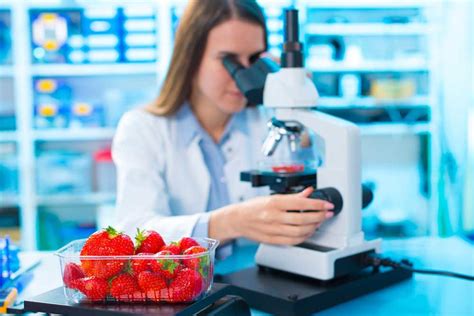Introduction:

Food science is a fascinating field that combines science, technology, and creativity to develop, improve, and ensure the safety of the food we eat. Food scientists play a pivotal role in various aspects of the food industry, from research and development to quality control and consumer safety.
Research and Innovation:
Food scientists conduct research to enhance the nutritional value, flavor, texture, and safety of food. They develop new food products, improve existing ones, and create innovative solutions to address challenges in the food industry.
- New Product Development: Food scientists use their knowledge of food science, nutrition, and culinary arts to create new food products that meet consumer demands and market trends.
- Product Improvement: They work on improving the quality, taste, and safety of existing food products using innovative technologies and formulations.
- Solving Food Industry Challenges: Food scientists address issues such as foodborne pathogens, food spoilage, and sustainable food production through research and development.
Quality Control and Safety:
Food scientists ensure the safety and quality of food by conducting rigorous testing and implementing industry standards.
- Food Safety: They develop and implement food safety programs to prevent contamination and ensure the food is free from harmful microorganisms and toxins.
- Quality Testing: Food scientists conduct chemical, physical, and sensory tests to assess the quality, freshness, and nutritional content of food products.
- Regulatory Compliance: They keep up-to-date with food regulations and ensure that food products comply with industry standards and government requirements.
Food Processing and Packaging:
Food scientists design and optimize food processing and packaging methods to preserve the quality and nutritional value of food.
- Food Processing Technologies: They develop and improve food processing techniques such as heating, cooling, freezing, and dehydration to ensure food safety and enhance product quality.
- Packaging Design: Food scientists design packaging materials and systems that protect food from contamination, spoilage, and damage during storage and transportation.
- Sustainability: They focus on developing sustainable food processing and packaging methods to reduce environmental impact and promote resource conservation.
Consumer Research and Marketing:
Food scientists conduct market research and work with marketing teams to understand consumer preferences, identify market trends, and develop products that meet the needs of consumers.
- Consumer Preferences: They conduct sensory evaluations and surveys to assess consumer liking, acceptability, and preferences for various food products.
- Product Marketing: Food scientists provide scientific and technical information to support marketing campaigns and educate consumers about the nutritional value and safety of food products.
- Food Labeling: They develop food labels that comply with regulations and provide accurate information to consumers about ingredients, nutritional content, and allergens.
Other Applications:
The field of food science extends beyond traditional food production. Food scientists also apply their expertise in various other industries and applications:
- Food Biotechnology: They use genetic engineering and fermentation technologies to develop new food products and improve the nutritional value and shelf life of food.
- Food Technology: They develop and apply innovative technologies such as nanotechnology and 3D printing to create novel food products and enhance food processing efficiency.
- Foodomics and Data Science: Food scientists use advanced analytical techniques and data science to study the composition, quality, and safety of food products.
Conclusion:
Food scientists play a vital role in ensuring the safety, quality, and innovation of the food we eat. They combine scientific knowledge, technological expertise, and creativity to develop new products, improve existing ones, and address challenges in the food industry. As the world continues to face challenges related to food security, sustainability, and consumer health, the demand for food scientists is expected to grow in the years to come.
Useful Tables:
| Table 1: Food Science Research and Innovation |
|—|—|
| Research Area | Goal |
| New Product Development | Create innovative food products that meet consumer demands |
| Product Improvement | Enhance the quality, taste, and safety of existing food products |
| Food Industry Challenges | Address issues such as foodborne pathogens, food spoilage, and sustainable food production |
| Table 2: Food Safety and Quality Control |
|—|—|
| Task | Purpose |
| Food Safety Programs | Prevent contamination and ensure food is free from harmful microorganisms and toxins |
| Quality Testing | Assess the quality, freshness, and nutritional content of food products |
| Regulatory Compliance | Ensure food products comply with industry standards and government requirements |
| Table 3: Food Processing and Packaging |
|—|—|
| Task | Goal |
| Food Processing Technologies | Preserve food quality and safety, enhance product quality |
| Packaging Design | Protect food from contamination, spoilage, and damage |
| Sustainability | Reduce environmental impact and promote resource conservation |
| Table 4: Other Food Science Applications |
|—|—|
| Area | Application |
| Food Biotechnology | Develop new food products, improve nutritional value and shelf life |
| Food Technology | Apply innovative technologies to create novel food products and enhance food processing efficiency |
| Foodomics and Data Science | Study food composition, quality, and safety using advanced analytical techniques and data science |
